It's rare to see a person without small dark marks on their body. Is it worth paying attention to these points? Only a doctor will distinguish between dangerous and normal moles - malignant melanoma or harmless nevus - and give recommendations on what to do with them. Is it worth worrying about the appearance of new formations, when immediate contact with specialists is required, what are the signs of cancer development - the answers to these questions remain to be found out. No one is immune from disaster, and early diagnosis will protect you from severe consequences.
What is a mole
The first tiny spots may appear in children in infancy. A mole is a small formation on the skin - a nevus - that is considered benign and harmless. The basis for their appearance is melanocyte cells that accumulate the natural pigment melanin. Depending on its quantity, a difference in color is observed. Available colors:
The shape of the tumors depends on the location and concentration of melanin. They may have a stalk or be located under the skin, be flat and convex. The most common type is round, but there are exceptions. The development of neoplasms is provoked by ultraviolet radiation - natural from the sun, in a solarium. Hereditary factors cannot be excluded. A common cause of growth is hormonal imbalance, characteristic of periods:
- puberty;
- pregnancy;
- menopause.
What types of moles are there?
One person may discover very different tumors. Types of moles are classified according to several criteria. This helps in correct diagnosis in case of changes. They differ in:
- origin– congenital, newly acquired;
- structure– pigment, vascular;
- place of education – in depth, on the surface, in the boundary layer;
- raised above the skin – flat – even, protruding as a hemisphere, pedunculated, larger birthmarks;
- potential threats – dangerous, degenerating into melanoma, non-dangerous.

Safe moles
Those who have dark spots on their skin should be wary of their changes. In time, detected signs of degeneration into melanoma contribute to the timely removal of the formation and preservation of health. Safe moles are different:
- the presence of a stalk – it cannot be formed by malignant cells that grow randomly;
- long-term condition without changes.
Spots that appear shortly after birth are not considered dangerous. It is important that they are small in size. Good – non-dangerous – signs of neoplasms include:
- flesh tone;
- unchanged pattern of the skin of the nevus and adjacent tissues;
- soft consistency;
- hair on the surface of the neoplasm - growing from the skin, indicates the absence of pathologies;
- diameter no more than 5 mm;
- symmetry;
- nevus in the form of a spot.
Which moles are dangerous?
Why do people with nevi on their bodies need to monitor their changes? There is always a threat of degeneration of non-dangerous tumors into a cancerous tumor. What moles are dangerous to health? Key signs you need to know:
- change in shades towards the dark side, the appearance of multi-color;
- rapid increase in size - exceeds two millimeters per year;
- occurrence of cracks;
- the formation of asymmetry due to uneven growth;
- lack of elasticity;
- the appearance of itching, burning;
- presence of discomfort.
The appearance of dangerous moles requires an immediate visit to a specialist to clarify the nature of the changes and the likelihood of developing skin cancer. Pathological transformations provoke:
- injury to the nevus due to negligence;
- self-removal;
- abuse of exposure to the sun, use of a solarium;
- location of the formation in places of frequent contact with clothing - on the neck, head, genitals, legs;
- placement in the hair, on the face, palms - where there is a high probability of injury;
- previously removed melanoma.
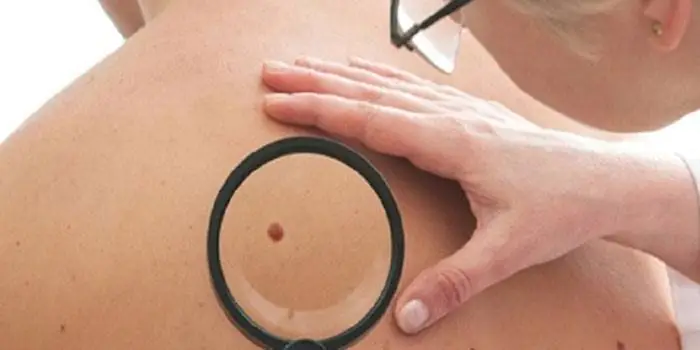
Why are moles dangerous?
Not a single person is protected from the sudden proliferation of cells of a harmless mole. Melanoma is an extremely serious disease. Changes not detected at the initial stage can result in death. The provoking factor is unsuccessful independent removal of tumors. Moles are dangerous because of their ability to:
- transform into an atypical – precancerous form;
- grow to large sizes;
- turn into cancerous;
- with minor external changes, metastases actively spread throughout the body through the circulatory and lymphatic channels.
How quickly does melanoma develop from a mole?
The transformation of a nevus into a cancerous formation can occur in different ways. The process depends on the stage of the disease and the type of tumor. Instant metastases are dangerous. Begins:
- growth of cancer (oncological) cells in the deep layers of the epidermis;
- their entry into the blood and lymph;
- penetration into the lungs, liver, kidneys;
- growth in these organs;
- complete damage to the body;
- death.
The growth phases of pigment cells are observed, along which melanoma develops from a mole. There are varieties:
- horizontal– damage to the upper layers of the skin occurs, lasting up to 10 years, but metastases do not appear;
- vertical– accompanied by the spread of cancer cells throughout the organs, can last two years, has an unfavorable prognosis;
- nodal – especially dangerous – characterized by deep spread within two months.
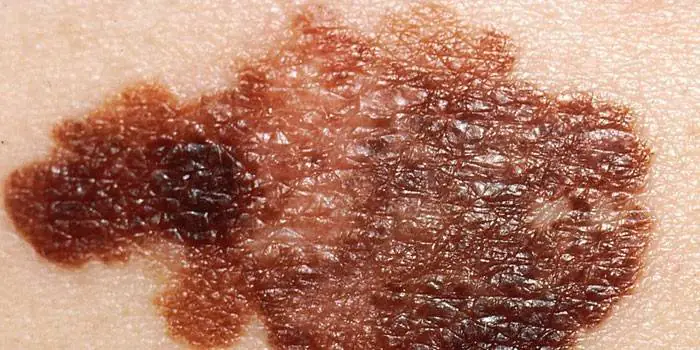
The first signs of melanoma
The patient can be assisted only when suspicious changes begin to be identified. The diagnosis, research, and referral for surgical treatment save a person’s life. The first signs of melanoma:
- increase in the height of the tumor;
- bleeding;
- the appearance of discharge;
- redness;
- burning, itching;
- swelling of tissues;
- softening of the nevus;
- the appearance of a crust;
- thickening;
- hair loss;
- expansion of pigmentation around the lesion.
With the further development of dangerous melanoma, the following are observed:
- significant change in size;
- the appearance of pain;
- enlarged lymph nodes;
- surface ulceration;
- formation of new foci;
- bleeding from places of pigmentation;
- liquid separation;
- skin thickening;
- the appearance of an earthy tint;
- signs of metastases are chronic cough, weight loss, cramps, headaches.
How to distinguish a mole from melanoma
To recognize which moles are dangerous and which are not dangerous, you need to know what they look like. A person with nevi, in order to avoid dire consequences, must constantly monitor the appearance of new formations and changes that occur. You can distinguish a mole from melanoma by its signs. Non-dangerous neoplasm:
- symmetrical;
- with smooth edges;
- uniform in color;
- with dimensions not exceeding 6 millimeters.
Features of dangerous melanoma that require seeking help from dermatologists:
- growth in a short time;
- pronounced asymmetry of shape;
- heterogeneity in color - the presence of inclusions of several shades;
- lack of clear boundaries - the contour line is blurred, jagged, and looks like a coastline on a geographical map;
- increased diameter over six millimeters;
- variability of any parameters - color, size, shape.

What dangerous moles look like
What do nevi that are subject to pathological changes look like? Only a doctor can correctly distinguish between non-dangerous tumors. Dangerous formations look like this:
- blue– compactions under the skin with clear boundaries, with dimensions no more than 10 mm;
- nodal– round, flat in shape, color – brown, black;
- cutaneous– often pale, convex;
- halo nevus – pigment surrounded by a light or white rim;
- spitz- looks like a dome-shaped tumor of pink shades, with the possible presence of a hole through which blood and liquid leak;
- connecting- connect individual entities into a whole.
Mole with jagged edges
One of the signs of a non-hazardous formation turning into a dangerous one is a change in contours. It often has blurred edges and scalloped borders. There are non-dangerous types of nevi - dysplastic. Only a specialist can make a correct diagnosis. A mole with uneven edges can be dangerous if there are additional signs of melanoma:
- accelerated changes in size;
- the presence of clearly defined asymmetry;
- the appearance of highly indented boundaries.
Rough mole
Such a neoplasm is harmless if its diameter is no more than 5 mm and remains constant in size. Often its appearance signals a lack of vitamins and nutritional disorders. Doctors advise coming for a consultation if it is discovered that:
- the smooth nevus turned into a rough one;
- bothered by burning, itching, tingling;
- irregularities and compactions appeared in the middle;
- areas with different shades formed;
- diameter has increased significantly.
A dangerous rough mole requires immediate examination if:
- the appearance of bleeding;
- development of the inflammatory process;
- rapid change in size;
- formation of asymmetry;
- formation of purulent discharge;
- the occurrence of painful sensations when touched;
- the emergence of an irregular shape, blurred boundaries, along the edges of the neoplasm.
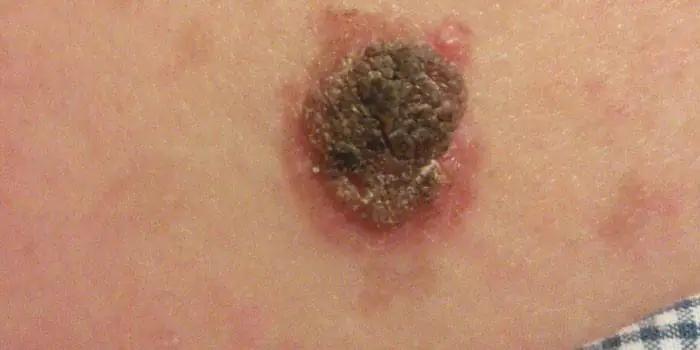
Large moles
Large formations on the skin are pigment spots. When they remain unchanged and do not cause inconvenience, this is not a dangerous phenomenon. It is important to constantly monitor their appearance, color, and size. To eliminate worries, you need to consult a dermatologist. During the visit, the specialist will conduct a diagnosis and give a forecast of the risk of developing a malignant neoplasm. Large moles become dangerous if they:
- injured;
- thickened;
- started to itch;
- were unsuccessfully removed independently;
- changed in size, shape;
- are bleeding.
What moles can be removed
Often nevi cause trouble for women when they are in a visible place - the face, neck. Even if they do not bother you, using removal will be the right decision - the appearance will improve significantly. After the procedure, the doctor must necessarily send the tissue for histological analysis to decide whether the mole is malignant or not. If the neoplasm is not dangerous, does not bother you, and does not change in size, surgery is not required. What moles cannot be removed? Experts believe:
- there are no contraindications;
- It is important to choose the right excision technique.
You should be careful about skin growths; it is unacceptable to remove them yourself. Only the doctor will determine whether a nevus is dangerous or not and decide what to do with it. You can delete it if:
- injured from clothing - on the neck, in the groin area, under the armpits;
- cause pain when touched;
- are located under the hair on the head and can be damaged when combing or cutting;
- change color, shape, outline;
- significantly increase in size;
- characterized by the presence of burning, itching;
- accompanied by inflammation and bleeding.
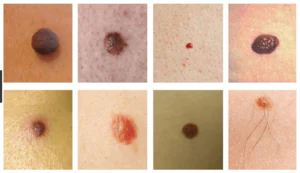
Birthmarks can be found on the body of any person. Usually these marks are not paid attention to, but in vain. LAny formation on the skin should not go without human attention. What types of stains are there, what can cause them, and in what cases should you seek help from a specialist?
In medicine, a mole on the body is called a nevus. This term refers to a congenital or acquired transformation of the skin, which is expressed in the growth or change in color of its individual places. Appearance of a mole very often associated with hormonal imbalances, ultraviolet radiation and various injuries.
Types of birthmarks
The types of moles are determined based on their shape, color, and overall size. In shape, neoplasms can be flat, oblong, round, smooth or with a rough surface. The skin color on moles can be light brown, any shade of red, black, and sometimes even purple, which will directly depend on the skin color of a particular person. The minimum size most often reaches 1 millimeter, and the maximum is very difficult to identify, since sometimes the formation occupies a significant area of the body.
Which moles are dangerous?? Depending on the threat to health, moles are divided into the following types:
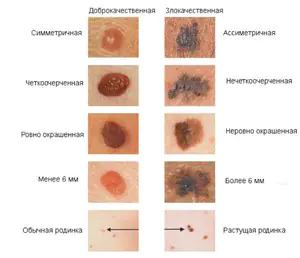
Nevus is a benign formation. Such a formation most often does not cause any discomfort to a person, the shape has clearly defined outlines, and the original color does not change. Many formations belong to this type.- Basalioma includes a precancerous condition of the spot.
- Melanoma. This name in medicine is given to all malignant moles. To determine it, it is necessary to undergo a thorough examination by an oncodermatologist and conduct a thorough diagnosis.

In the medical literature you can often find structural types and their detailed photos with descriptions. Pigment spots to the touch quite smooth, but in some cases may have a rough surface due to the small amount of hair. The color is most often dark.
Vascular ones differ from other types in different shades of red, since their structure contains vessels of the circulatory system; their shape is convex. The last variety in the structural classification is warty. In color and appearance they are more reminiscent of simple warts. The difference lies only in the nature of their occurrence. Warts most often have a viral structure. Women's skin is more susceptible to developing warty spots on it than men. About 10 percent of such formations may pose a serious risk of developing cancer.
Types of formations
Skin formations depending on diagnosis, exhibited by dermatologists, come in six varieties:.
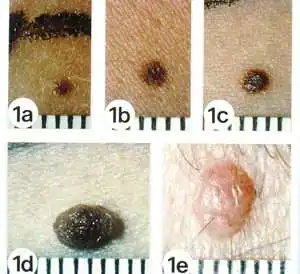
Lentigo is a borderline neoplasm. They are small in size and general shape and resemble freckles in appearance. The main distinguishing feature is considered to be a darker and brighter shade.- The epidermodemal type most often forms in the intimate area, on the palms and soles. The shade of the formation can be different (varies from flesh-colored to bright black).
- Sutton's nevi. The skin next to such a spot does not contain pigment; this type is easily distinguished from other formations. A spot on a person’s body can disappear on its own, and after some time it can appear again.
- Dysplastic moles most often affect the body of a healthy person after 35 years of age and have a hereditary pattern of occurrence. They are most often found on areas of the body that are not exposed to sunlight. They can reach up to twelve centimeters in diameter.
- Nevi are blue. Their colors can vary from light blue to bright blue. The most dangerous spots of this variety are cellular nevi.
- A large pigmented nevus is considered congenital. Considering the fact that the neoplasm continues to grow larger as a person grows older, in some cases it acquires impressive dimensions. Most often it has a flat shape.
The human body can contain several types of nevi at the same time. Most of them do not pose any particular danger, but in order to identify malignant formations in time, you need to treat them with increased care.
How to recognize dangerous moles
A safe mole on the surface of the skin, as a rule, has a clear contour with smooth edges, is painted in a uniform color, and its diameter does not exceed 5 millimeters. There are also some risk factors, the presence of which in a person significantly increases the possibility of transforming a simple mole into melanoma. These include:

frequent sunburn;- light skin color and a large number of freckles;
- men, especially at an older age, are susceptible to neoplasms;
- relatives who had a history of malignant spots;
- if a person has too many moles on his body.
A particular danger is the presence of moles such as blue and borderline nevus. They need to be given special attention.
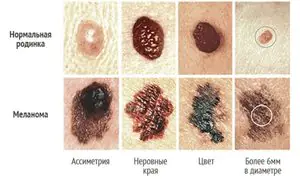
In order to timely slow down the dangerous processes associated with such moles, you need to carefully and independently examine the surface of the body for changes in their appearance. Zprotect yourself from harmful effects A simple self-diagnosis formula proposed by dermatologists will help - this is ACORD. This abbreviation includes the main signs of the development of a malignant formation in the body: asymmetry, edges, overall size, color and dynamics of spread throughout the body.
A harmless mole has symmetrical halves if you imagine drawing a straight line through its center. For greater clarity, you can attach a ruler. In addition, it is important to understand what dangerous moles look like. Malignant moles will not have common boundaries; their edges are very blurred. The color of such a mole is uneven.
If, after examining the body, you find such spots, then you need to monitor them. Such formation very often changes its appearance. You can first measure the size; if after several days the nevus has increased in size, then this is a sign of a dangerous formation. Also, when a person discovers a mole, they should be alert to their diameter being greater than six millimeters.
Minor signs of a painful spot
The considered indicators are considered the most important in determining a dangerous formation, but there are also secondary ones that will also indicate a dangerous type of stain. These include:
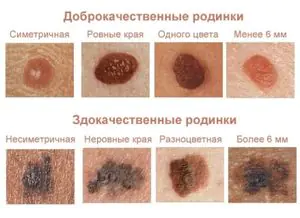
The presence of an inflammatory process, during which the skin near the mole begins to acquire a red tint and becomes painful.- Bleeding, fluid secretion, crusting. Also, such formations are often covered with small ulcers.
- Most often, moles increase in length rather than in width.
- The surface of the spot begins to become covered with satellites (multiple pink inclusions).
- Detection of a stalk of a nevus. The nodular type can usually be found on the neck, back and limbs.
- A change in the matte surface of the birthmark and the development of a slight reflection on it.
External signs of a mole can only give tentative conclusions. Only your attending specialist can give you an accurate and correct diagnosis after performing a biopsy.
Consultation with a doctor
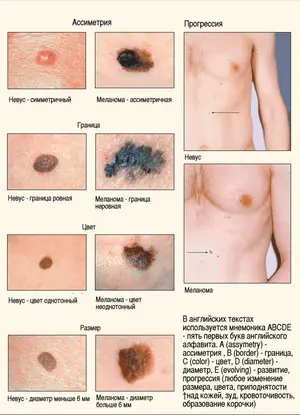
You need to know that detecting melanoma on the body at an early stage increases the possibility of a complete cure. Detection of any change, even not very significant, is considered grounds for visiting a specialist for a more complete examination. If a mole in the facial area begins to bleed heavily and itching develops, which gets worse all the time, then this is a very unfavorable sign. The situation can get much worse if you begin to feel a pulsation in the birthmark itself. Perhaps such a mole belongs to a blue nevus, which is very often modified into melanoma.
It is imperative to go to see a doctor if the birthmarks have increased in diameter so much that they only cause pain and inconvenience to the person when they come into contact with clothing. Sometimes the pain and redness is only temporary, but don't let your body confuse you. After some time, all the unpleasant symptoms will return again, but at this time they will become much stronger and more unpleasant.
Light skin, which has a large number of birthmarks, requires a more attentive and serious attitude. Deaths often occur when melanoma is detected late. Its main danger lies in the fact that metastases occur almost immediately, affecting the internal organs of a person.
Currently, modern diagnostics includes methods for identifying dangerous moles that are completely safe and painless for humans (good procedures are: x-rays, computed tomography, laboratory tests, biopsy). Large moles must be removed without fail to prevent any oncology from occurring. At the moment, their elimination occurs surgically with the use of radiation therapy.
Folk signs
At all times, people have tried to understand the reason for this or that arrangement of formations on their bodies. Such spots, appearing in different places, can provide an answer to any question if you know how to correctly interpret the meaning of their location on the body.
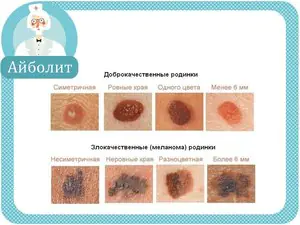
A mole on the face of men will help make it clear about their attitude towards family life. If you see a spot in the corner of the left eye, then it indicates a jealous character. But a man with a mole near his right eye will turn out to be a real family man and would never trade his family for anything. If the spot is in the center of the forehead, then this indicates increased love and frivolity. A nevus on the eyelid indicates high intellectual abilities.- Skin on the back with a large number of moles will show the owner’s grouchy, but at the same time open character. Nevi on the legs will indicate a person’s indecisiveness. But if they are on the feet, then their meaning can be associated with travel.
- A woman whose moles cover her body or face can also find a certain meaning in them. Location in the lip area very often indicates a passionate nature, the skin of the cheeks indicates hot temper, but quick reconciliation. If the mole is located between the eyebrows, then the woman is endowed with great intelligence and excellent intuition.
- After a thorough examination of her body, a woman is even able to determine how many children she will have in the future. By counting all the moles on the waist, you can get the answer. The skin on the shoulders and arms along with birthmarks speaks of good luck, success in work and a happy family life.
- The meaning of the spot depends not only on the part of the body where it is located, but also on the general appearance and shape. For example, there is an opinion that triangular-shaped moles can be found not only in a person with strong energetic and extrasensory abilities. According to another version, the skin of indigo people very often has this sign. If this type of formation is located on the inside of the palm, then this indicates particular success in the field of communication. Finding such a sign on the head promises a successful scientific career.
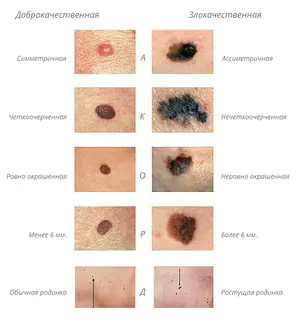
In conclusion, we need to talk about preventive measures that will help reduce the risk of a mole changing to a malignant form. There is no need to injure birthmarks; if they are in a place that is constantly in contact with clothing, such a nevus should be removed. When taking a shower, you should use only soft sponges.
Moles that have a stalk or nodule are prohibited from being removed on your own, even if you think that the nodule is quite thin. Protect your skin from sun exposure, especially if you have a large number of moles. You should also avoid frequent visits to the solarium. According to the results, which were carried out in California, it turned out that from the first trip to the solarium for people at risk until the first detection of melanoma in them takes from 5 to 10 years.
Every adult has moles on their body. They all look different and sometimes it can be difficult to figure out which ones are dangerous to health and which ones are not. In this article I will try to talk in simple human language about the main types of moles. Read this text to the end and you will be able to make a preliminary diagnosis yourself with a high probability.
It is important to understand that the word "mole" is not a diagnosis in the medical sense of the word. This is usually used to refer to everything that protrudes above the skin. Below are the most common benign lesions.
Pigmented nevus (mole, birthmark, age spot)
It is a collection of pigment-producing cells (melanocytes or nevus cells)
- Form: may take the form of a spot, nodule or plaque on a broad base, protruding above the level of the skin.
- Surface: smooth or cauliflower-like. Sometimes the skin pattern remains.
- Consistency: most often - elastic or soft.
- Color: Mostly brown. If the formation contains even the slightest shades of brown, it is most likely a pigmented nevus.
- Health Hazards: Trauma and sunburn can lead to the transformation of a nevus into melanoma or skin cancer.
- Possible changes that do NOT indicate malignant degeneration: may increase by 1-2 mm per year, may become convex.
- How to distinguish from other moles: the most characteristic signs for a nevus are brown color (from light brown to brown-black) and a wide base adjacent to the skin

Papilloma (hanging mole)
A benign skin tumor caused by the human papillomavirus.
Appearance: Frequent locations of papillomas are the eyelids, neck, armpits, area under the mammary glands, and perineum. In other places, papillomas are very rare.

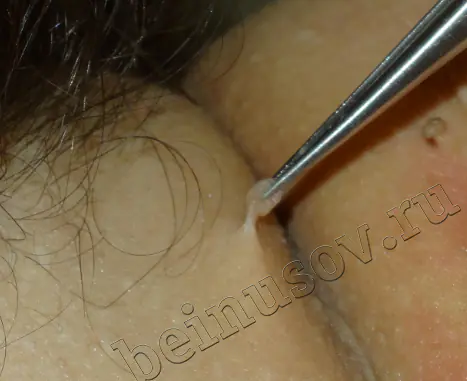
- Form: A distinctive feature of papillomas is the presence of a thin base (“leg” 1-2 mm thick), on which a larger nodule is located. Also, the shape of the papilloma can be cylindrical or cone-shaped, but in any case, the height of the formation will prevail over the width.
- Surface: smooth or cauliflower-like
- Consistency: most often soft, in rare cases - dense
- Color: flesh or brown
- Health Hazards: has no idea. Cases of tumors developing from papillomas have not been described.
- Possible changes that do NOT indicate malignant degeneration: can significantly increase in size while maintaining the stalk, the number of papillomas can also increase significantly.
- How to distinguish from other moles: The most characteristic sign of papillomas is a thin “leg”

A benign skin tumor caused by the human papillomavirus.



